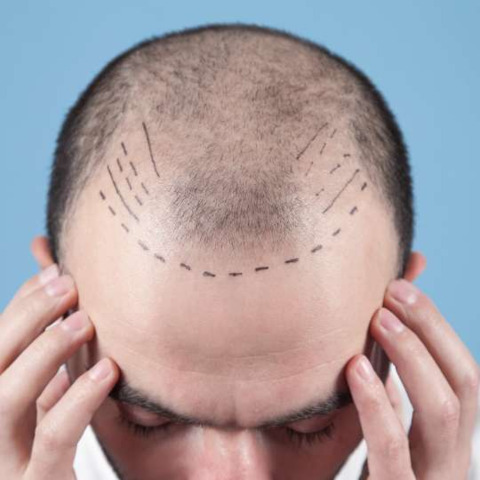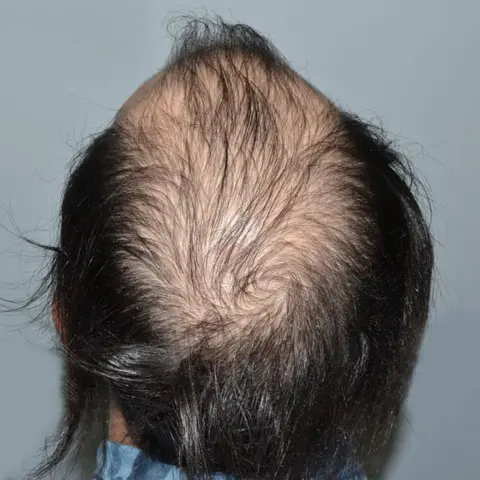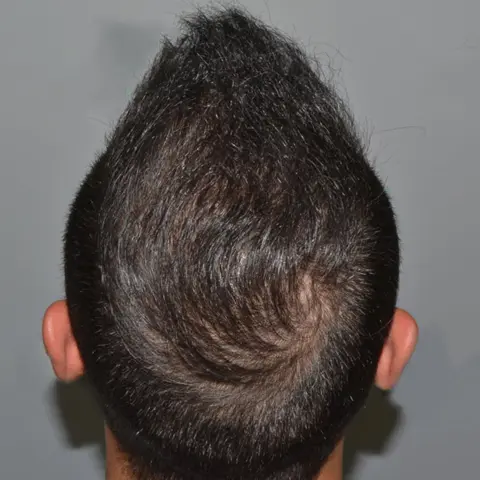

The DHI (Direct Hair Implantation) technique is an advanced hair transplant method that involves directly implanting individual hair follicles into the recipient area of the scalp. The procedure is performed using a specialized tool called a "Choi Implanter Pen" that enables precise control over the depth, angle, and direction of the implanted hair follicles.
This technique minimizes the time hair follicles spend outside the body, which helps to preserve their health and increase the chances of successful growth in the recipient area. DHI is known for its ability to deliver more natural-looking results, as well as being less invasive and causing less trauma to the scalp compared to traditional FUE and FUT hair transplant methods.
The DHI technique differs from FUE and FUT hair transplant methods in several ways:
- Extraction: In FUE (Follicular Unit Extraction), individual hair follicles are extracted one by one from the donor area using a micro-punch, whereas, in FUT (Follicular Unit Transplantation), a strip of scalp containing hair follicles is removed from the donor area. In DHI, like FUE, individual hair follicles are extracted one by one.
- Implantation: The key difference between DHI and the other methods lies in the implantation step. In FUE and FUT, extracted hair follicles are implanted into the recipient area using forceps or other instruments after creating tiny incisions. In DHI, the extracted hair follicles are loaded into a Choi Implanter Pen, which is then used to implant the hair directly into the recipient area without the need for pre-made incisions.
- Precision and control: The Choi Implanter Pen used in DHI allows for greater control over the depth, angle, and direction of the implanted hair follicles, resulting in a more natural-looking hairline and overall appearance.
- Reduced trauma and healing time: DHI is less invasive than FUT, as there is no need for a strip of scalp to be removed, and causes less trauma to the scalp than FUE, as there are no incisions made prior to implantation. This often leads to faster healing and less post-operative discomfort.
- Graft survival rate: Due to the reduced time hair follicles spend outside the body in the DHI technique, graft survival rates tend to be higher compared to FUE and FUT methods.
While DHI offers several advantages, it may not be suitable for all patients and hair transplant cases. The choice of technique depends on individual factors, such as the extent of hair loss, donor hair quality, and the patient's expectations and goals.
The advantages of the DHI (Direct Hair Implantation) technique compared to other hair restoration methods like FUE (Follicular Unit Extraction) and FUT (Follicular Unit Transplantation) include:
- Less invasive: DHI is less invasive than FUT, as there is no need for a strip of scalp to be removed. The implantation process in DHI also does not require pre-made incisions, resulting in reduced trauma to the scalp.
- Faster recovery: With DHI, patients typically experience a faster recovery time and less post-operative discomfort compared to FUT and, in some cases, even FUE.
- Suitable for various hair types: The DHI technique can be used for patients with different hair types, including thin and weak hair, allowing for a wider range of candidates.
- Less scarring: Since there is no strip of scalp removed and no incisions made during the implantation process, DHI generally results in less visible scarring compared to FUT and, in some cases, even FUE.
The procedure for a DHI (Direct Hair Implantation) hair transplant in Turkey typically involves the following steps:
1. Consultation and planning: The patient meets with the hair transplant specialist to discuss their goals, assess their hair loss, and determine the appropriate treatment plan. The donor and recipient areas are marked, and the desired hair density and direction are determined.
2. Hair trimming: The donor area, usually at the back of the head, is trimmed to facilitate the extraction process.
3. Anesthesia: Local anesthesia is administered to both the donor and recipient areas to ensure a pain-free procedure.
4. Extraction of hair follicles: Using a micromotor and fine punch, individual hair follicles are carefully extracted from the donor area.
5. Preparation of hair grafts: The extracted hair follicles are kept in a special solution at a controlled temperature to ensure their viability.
6. Implantation: The hair transplant specialist uses a Choi Implanter Pen to implant the hair grafts directly into the recipient area, without the need for pre-made incisions. This allows for precise control over the depth, angle, and direction of the implanted hair follicles, resulting in a natural-looking result.
7. Post-operative care: The patient is given detailed instructions for post-operative care and follow-up appointments are scheduled to monitor the progress of the hair transplant.
The duration of a DHI hair transplant procedure can vary depending on the number of grafts required and the individual patient's characteristics. Generally, a DHI hair transplant can take anywhere from 4 to 8 hours, with larger sessions potentially spanning over two consecutive days.
A good candidate for the DHI hair transplant technique typically has the following characteristics:
- Sufficient donor hair: A strong, healthy donor area at the back and sides of the head is crucial for a successful DHI hair transplant. This area should have enough hair follicles to provide the required grafts for the recipient area.
- Realistic expectations: It's essential to have realistic expectations about the results of the DHI hair transplant, as the outcome depends on factors like the quality and quantity of the donor's hair, the extent of hair loss, and the individual's hair characteristics.
- Good general health: The patient should be in good overall health to minimize the risk of complications and ensure a smooth recovery. Chronic illnesses, infections, or other medical conditions should be discussed with the hair transplant specialist during the consultation.
- Age: While there's no strict age limit for undergoing a DHI hair transplant, it's generally recommended for patients above the age of 25, as hair loss patterns may not be fully established in younger individuals.
- Non-smoker: Smoking can negatively impact the healing process and the success of the hair transplant. It's advised to quit smoking or at least refrain from smoking for a few weeks before and after the procedure.
It's essential to consult with a qualified hair transplant specialist who can assess your individual situation and determine if the DHI technique is suitable for you.
The recovery process after a DHI hair transplant is generally similar to that of other hair transplant techniques. Here's what you can expect during your recovery:
- Immediate post-procedure: After the surgery, your scalp may be red, tender, and slightly swollen. The doctor will provide you with necessary medications, such as painkillers and antibiotics, to manage discomfort and prevent infection.
- First few days: You might experience some minor discomfort, itching, and tightness on the scalp. It's essential to follow your surgeon's instructions, keep the area clean, and avoid touching the grafts. You should also avoid strenuous activities and exercise for the first week.
- First week: You may be instructed to wear a loose-fitting hat to protect the grafts from sun exposure and dust. You'll also need to sleep with your head elevated to minimize swelling. Your surgeon will give you guidelines on when you can gently wash your hair and how to do so without disturbing the grafts.
- Two to three weeks: During this period, the transplanted hairs may start to shed. This is a normal part of the process and is known as "shock loss." The hair follicles remain in place and will start to produce new hair in the coming months.
- Three to four months: New hair growth typically begins around this time, and the transplanted hair will start to grow at a regular rate.
- Six to twelve months: Most patients will see significant hair growth and improvement in the appearance of their hair within this time frame. The final results of the DHI hair transplant should be apparent after a year.
It's essential to follow your surgeon's post-operative instructions and attend all follow-up appointments to ensure the best possible outcome for your DHI hair transplant.
The results of a DHI hair transplant are generally long-lasting. Once the transplanted hair follicles have established themselves in the recipient area, they should continue to grow hair for the rest of the patient's life. However, it's essential to understand that hair loss can still progress in other areas of the scalp that were not treated with the hair transplant.
Individual factors, such as heredity, overall health, and the degree of hair loss, can impact the longevity of the results. To maintain the best possible outcome, patients should:
- Follow a healthy lifestyle, including proper nutrition and regular exercise, to promote overall well-being and support hair growth.
- Consider using FDA-approved medications like minoxidil or finasteride, if recommended by the doctor, to help slow down hair loss in non-transplanted areas.
- Protect the scalp from sun exposure and other environmental factors that may negatively impact hair growth.
It's crucial to have realistic expectations and maintain open communication with your hair transplant surgeon to ensure the best possible results. They can provide personalized advice and guidance on how to preserve and enhance your hair transplant results.
The cost of a DHI hair transplant in Turkey is significantly lower than in the USA and Western Europe. In Turkey, the cost of a DHI hair transplant ranges from $2,500 to $5,500, while in the USA and Western Europe, the cost can range from $8,000 to $30,000. There are a few reasons for this difference in price.
First, the cost of living in Turkey is much lower than in the USA and Western Europe. Second, there are many experienced hair transplant surgeons in Turkey who offer high-quality care at a fraction of the cost of surgeons in other countries. Finally, many hair transplant clinics in Turkey offer all-inclusive packages that include transportation, accommodation, and other expenses, which can further reduce the overall cost of the procedure.
Choosing Elara Medical Tourism for your DHI hair transplant procedure in Turkey offers numerous benefits:
1. Experienced and skilled surgeons: We collaborate with some of the most experienced and well-trained hair transplant surgeons in Turkey, ensuring that you receive the highest quality of care.
2. High-quality facilities: Our partner clinics and hospitals are equipped with state-of-the-art technology and modern facilities to provide a comfortable and safe environment for your hair transplant procedure.
3. Affordable pricing: We offer competitive prices for DHI hair transplant procedures compared to Western Europe and the USA, without compromising on quality and safety standards.
4. Personalized care: We understand that each patient has unique needs and expectations, which is why we tailor our services to meet your specific requirements, ensuring a customized and satisfying experience.
5. Comprehensive support: From the moment you contact us until your post-procedure recovery, our team is here to support and guide you throughout the entire process. We assist with travel arrangements, and accommodation, and provide any necessary information to make your medical journey as smooth as possible.
By choosing Elara Medical Tourism for your DHI hair transplant procedure, you can trust that you'll receive top-notch care and support to achieve the best possible results for your hair restoration journey.


Seamless Solutions: DHI Before and After Hair Perfection





